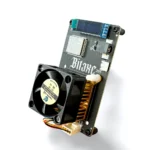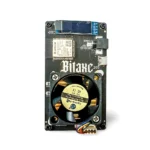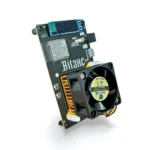How does Bitaxe Ultra compare to other ASIC miners in energy consumption?
How Does Bitaxe Ultra Compare to Other ASIC Miners in Energy Consumption?
The cryptocurrency mining landscape has evolved dramatically over the past decade, with energy efficiency becoming a critical factor for miners seeking profitability and sustainability. As the industry matures, miners are increasingly scrutinizing the power consumption of their hardware, as it directly impacts operational costs and environmental footprint. Enter the Bitaxe Ultra, an innovative ASIC Bitcoin solo miner that challenges traditional norms with its groundbreaking energy efficiency and open-source architecture. But how does it stack up against other ASIC miners in terms of energy consumption? Let’s dive in.
Introducing the Bitaxe Ultra: A Game-Changer in Bitcoin Mining
The Bitaxe Ultra is a compact yet powerful ASIC miner designed specifically for Bitcoin mining. What sets it apart from other miners is its unique combination of open-source architecture, exceptional energy efficiency, and decentralized mining capabilities. Powered by the proven BM1366 ASIC chip, the Bitaxe Ultra delivers a hashrate of 500 GH/s while consuming just 15 watts of power. This translates to an impressive efficiency ratio of 33.3 GH/s per watt, positioning it as one of the most energy-efficient miners in its class.

Beyond its technical specifications, the Bitaxe Ultra is the world’s first open-source ASIC miner, fostering transparency and community-driven innovation. Its compact design (10 x 6 cm) and lightweight build (73g) make it versatile for various deployment scenarios, while its advanced cooling system ensures optimal thermal management. But perhaps its most significant advantage lies in its energy efficiency—a feature that makes it a standout contender in the competitive mining hardware market.

The Importance of Energy Efficiency in ASIC Mining
Before comparing the Bitaxe Ultra to other ASIC miners, it’s essential to understand why energy efficiency matters in the first place. Bitcoin mining is an energy-intensive process, and electricity costs often represent the largest ongoing expense for miners. In regions where electricity prices are high, inefficient miners can quickly erode profitability. Additionally, the environmental impact of mining has drawn increasing scrutiny, pushing miners to adopt more sustainable practices.
Energy efficiency is typically measured in hashrate per watt (GH/s/W), which indicates how much computational power a miner can deliver for each unit of energy consumed. The higher this ratio, the more cost-effective and environmentally friendly the miner. With this in mind, let’s explore how the Bitaxe Ultra compares to other popular ASIC miners.
Comparing Bitaxe Ultra to Other ASIC Miners
1. Bitmain Antminer S19 Pro
- Hashrate: 110 TH/s
- Power Consumption: 3,250 watts
- Efficiency: 33.8 J/TH (approximately 29.6 GH/s per watt)
The Antminer S19 Pro is one of the most popular ASIC miners on the market, known for its high hashrate and reliability. However, its power consumption is significantly higher than the Bitaxe Ultra, making it less suitable for small-scale or home-based mining operations. While its efficiency ratio is slightly better than the Bitaxe Ultra, the S19 Pro requires a much larger upfront investment and ongoing electricity costs, which may not be feasible for all miners.
2. MicroBT Whatsminer M30S++
- Hashrate: 112 TH/s
- Power Consumption: 3,472 watts
- Efficiency: 31 J/TH (approximately 32.3 GH/s per watt)
The Whatsminer M30S++ is another high-performance ASIC miner, offering a slightly better efficiency ratio than the Bitaxe Ultra. However, like the Antminer S19 Pro, it consumes thousands of watts of power, making it impractical for miners with limited resources or those looking to minimize their environmental impact. The Bitaxe Ultra’s ultra-low power consumption of just 15 watts makes it a more accessible and sustainable option for individual miners.
3. Canaan AvalonMiner 1246
- Hashrate: 90 TH/s
- Power Consumption: 3,426 watts
- Efficiency: 38 J/TH (approximately 26.3 GH/s per watt)
The AvalonMiner 1246 is a solid performer but falls short in energy efficiency compared to the Bitaxe Ultra. Its higher power consumption and lower efficiency ratio make it less attractive for miners focused on long-term profitability and sustainability. The Bitaxe Ultra’s compact design and low energy requirements give it a clear edge in this comparison.
4. Innosilicon T3+
- Hashrate: 52 TH/s
- Power Consumption: 2,200 watts
- Efficiency: 42 J/TH (approximately 23.8 GH/s per watt)
The Innosilicon T3+ is another example of a miner that prioritizes hashrate over energy efficiency. While it delivers decent performance, its high power consumption and lower efficiency ratio make it less competitive when compared to the Bitaxe Ultra. For miners operating on a budget or in regions with high electricity costs, the Bitaxe Ultra’s low power draw is a significant advantage.
Why Bitaxe Ultra’s Energy Efficiency Matters
The Bitaxe Ultra’s 15-watt power consumption is a game-changer for several reasons:

- Lower Operational Costs: With electricity being a major expense in mining, the Bitaxe Ultra’s ultra-low power draw translates to significantly reduced operational costs. This makes it an ideal choice for individual miners or small-scale operations.
- Sustainability: As the cryptocurrency industry faces increasing scrutiny over its environmental impact, the Bitaxe Ultra offers a more sustainable mining solution. Its energy-efficient design minimizes its carbon footprint, aligning with the growing demand for eco-friendly practices.
- Accessibility: Traditional ASIC miners often require substantial upfront investment and access to cheap electricity to remain profitable. The Bitaxe Ultra’s low power consumption makes it accessible to a broader range of miners, including hobbyists and those in regions with higher electricity costs.
- Decentralization: By enabling solo mining with minimal energy requirements, the Bitaxe Ultra contributes to the decentralization of the Bitcoin network. This aligns with Bitcoin’s original vision of a distributed and resilient financial system.
Practical Applications of the Bitaxe Ultra
The Bitaxe Ultra’s energy efficiency and compact design make it suitable for a variety of mining scenarios:
- Home Mining: Its low power consumption and quiet operation make it ideal for home-based mining setups.
- Educational Purposes: The open-source nature of the Bitaxe Ultra makes it a valuable tool for learning about Bitcoin mining and blockchain technology.
- Small-Scale Operations: Miners with limited resources can benefit from the Bitaxe Ultra’s affordability and efficiency.
- Decentralized Mining: By enabling solo mining, the Bitaxe Ultra empowers individuals to contribute directly to the Bitcoin network.
Conclusion: A New Standard in Energy-Efficient Mining
The Bitaxe Ultra represents a significant leap forward in ASIC mining technology, offering unmatched energy efficiency in a compact and accessible package. While it may not compete with high-end miners in terms of raw hashrate, its ultra-low power consumption and open-source architecture make it a compelling choice for miners prioritizing sustainability, affordability, and decentralization.
In a world where energy efficiency is becoming increasingly important, the Bitaxe Ultra stands out as a pioneer in sustainable mining. Whether you’re a hobbyist, a small-scale miner, or an advocate for decentralization, the Bitaxe Ultra offers a practical and environmentally friendly solution for participating in the Bitcoin network. As the mining industry continues to evolve, the Bitaxe Ultra sets a new standard for what’s possible in energy-efficient ASIC mining.